18 Animals
A pet's-eye view
Kevin Meredith
The Idea
This section is not a guide to shooting wild animals, more the domestic kind. Photographing animals can be tricky as they are not very good at taking direction. That said, some humans are not very good at taking direction, but at least animals have the excuse of not understanding!
Dog and Fish
Getting eye contact with an animal is often a matter of patience, or clicking your fingers.
The Ingredients
- ▶ Any camera
- ▶ A pet-yours or someone else's
The Process
My top tip for shooting animals, above all else, is to shoot from their perspective, This one thing will get you images that feel more real. We are used to looking down on most animals, so if you shoot images from their height, you will present the viewer with something unique.
If you want an animal to look at you, but you don't want to call for its attention in case it runs off, it's probably best to get it in shot, get focus lock, and wait until it looks at you, With luck it will turn to look at the camera, and when it does you will have your shot-you just need to be patient.
An animal shot doesn't have to include the whole subject-you can focus on just one part, such as the ears or nose. In Wild Donkey, on page 111. 1 decided to show only the out-of-focus nose and legs. Such a crop can give some insight into the character of the animal, in this case the donkey's inquisitive nature.
If you are going to photograph your pets, it's always best to shoot them in natural light as this avoids the use of flash. Cats and certain other animals have a reflective layer inside their eyes, which helps them see in the dark. If the light from a flash hits this, you can get bright white eyes rather than the red eyes that are a problem with human subjects, Another downside of using a flash is that it can freak animals out, If you want to get a photo of your pet looking calm, it is best to shoot when they are tired or when they have just woken up as at these times they are more likely to stay in one place.
It is always important to have the eyes of your subject in focus: the viewer will be drawn straight to the eyes in a photo, so out-of-focus eyes will be obvious, This is easier said than done when your subject doesn't understand that they have to sit still. If you are shooting digitally, you're best off firing loads of shots and finding what works once you are done.
Cats can be tricky because they are very easily spooked, especially if they are not yours. I like getting them at their level, so for Wild Cat, I held the camera very close to the ground and moved slowly forward, I was using a Lomo LC-A, a zone-focus camera, which meant I had to set the distance from my camera to the cat. In this case, 1 set the focus to 00cm (c. 21/2ft) and moved toward the cat very slowly so as not to scare him, Once I thought I was 80cm from the cat, I took my shot, Luckily I estimated the distance spot on. If you are using an autofocus camera for this type of shot, be mindful of keeping your subject in the center of the frame so that the autofocus is pointing at your subject. This can be tricky if you are not looking through the viewfinder. When you are taking photos for which you have to use a little guesswork regarding the focus, it's a good idea to close the aperture down so you have a wider depth of field; this will result in more of the image being in focus, so you have more chance of getting your subject sharp. {You can read more about depth of field on page 285.)
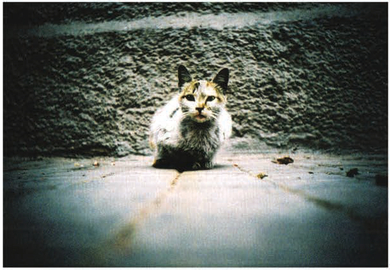
Wild Cat For all intents and purposes, this shot is of a wild animal. I took it when I was on holiday in Morocco—there were a lot of very wild-looking cats knocking about.
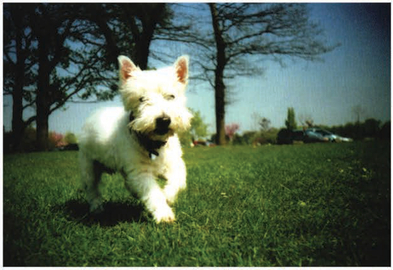
White Terrier This terrier was particularly tricky to photograph, as I had to move around with him. shooting blindly, hoping that he would be in shot and m focus.
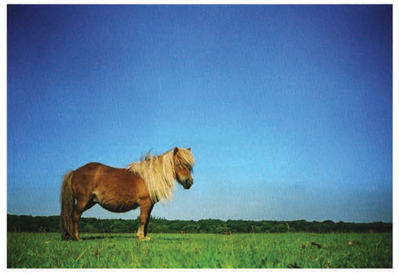
Shetland Pony I don't know why, but I find my horse shots always turn out a little amusing I shot this pony from low down so her belly was set against the sky as a background lb exaggerate her fatness.
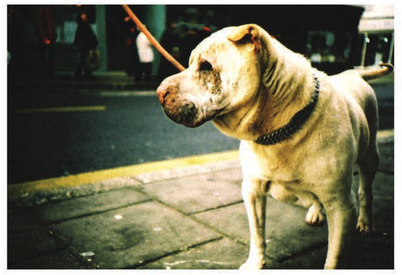
Focused Dog I tried to get I his dog to look at me, but he was not playing along. In any case, this profile shot worked out well because he is looking into the empty space in the frame.
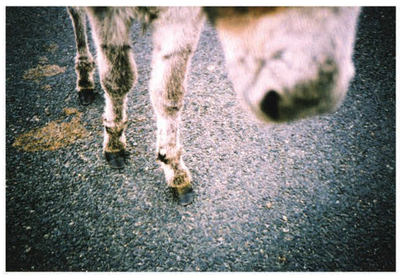
Wild Donkey I decided not to include the whole animal; this image shows more character than if I had shot the full donkey.
My approach to shooting animals might seem a little slapdash, and you might ask yourself "Why not get a zoom lens and shoot them from a distance?" I believe that by using a wider lens, you capture an image that is closer to what the human eye sees, so the image seems more natural. Also, by being closer to the animals when you shoot them, you get a chance to interact with them and capture their reactions to you,

